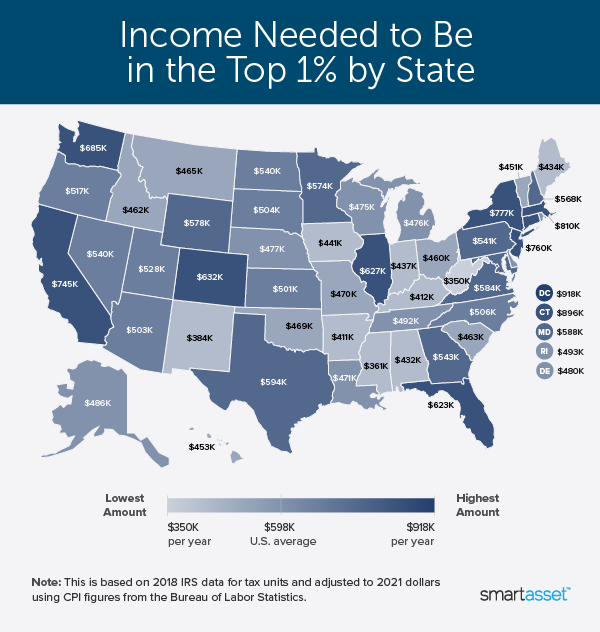What It Takes to Be in the 1% By State – 2022 Study

An American family needs an income of $597,815 to be considered in the top 1% of earners nationwide. This, however, varies from state to state. In Connecticut, a family needs almost $900,000 in annual income to be in the top 1% of earners in their state, whereas a family in the top 1% of West Virginia needs only an average of just over $350,000.
In this study, SmartAsset analyzed data to determine the minimum income required to be among the top 1% of earners in each state. To do so, we used data from the IRS and Bureau of Labor Statistics. For more information on our sources and how we ranked states, check out our Data and Methodology section below.
Key Findings
-
Coastal states have the highest 1% income threshold. Unsurprisingly, it takes the most to make it into the 1% of earners in big coastal states where major cities are located. The top five states are all on the East and West Coasts, and a total of eight coastal states rank in the top 10.
-
Top 1% earners pay at least 25% of the total income tax share in their states. Top 1% earners in Nevada paid the highest total income tax share (50.10%) out of all 1% earners in 50 states. While those in Alaska paid the lowest (24.92%). Nationally, the top 1% of earners contribute to 35.79% of all individual income taxes paid.
-
The top 1% nationwide earns twice as much as the top 5%. The minimum income threshold needed to be considered among the top 1% of earners ($597,815) is 2.48 times higher than the threshold needed to crack the top 5% of earners nationwide ($240,712).
States Where the 1% Income Threshold Is the Highest
1. Connecticut
To be in the top 1% of taxpayers in Connecticut, you’ll need to earn at least $896,490. To be in the top 5%, meanwhile, you’ll need to earn at least $311,589. The average income tax burden for those in the 1% is 27.59%.
2. Massachusetts
Bay State residents need to earn $810,256 annually to be in the top 1% of all earners and $314,389 to land in the top 5%. The top 1% pay 40.19% of total income taxes in Massachusetts.
3. New York
New York’s cutoff to be in the 1% is $777,126. The 1% pays an average income tax rate of 27.09%, while what they pay accounts for 48.10% of all income taxes paid.
4. New Jersey
One percenters in New Jersey must earn at least $760,462, while the cutoff to land in the top 5% is $308,976. The top 5% pay 56.23% of all income taxes in the Garden State.
5. California
An adjusted gross income (AGI) of $745,314 will get you in the 1% in California, while you’ll need to earn $291,277 to be in the top 5% of income earners. The top 1% account for 41.55% of total Golden State income taxes.
States Where the 1% Income Threshold Is the Lowest
1. West Virginia
The income needed to be in the top 1% in West Virginia is $350,212, while it takes $171,135 to be part of the top 5%. The top 5% of West Virginia income earners pay 48.25% of all income taxes in the state.
2. Mississippi
The top 1% in Mississippi earn upwards of $361,462. The average tax rate for these top earners is 22.67%, and their payments make up 32.98% of all income taxes in the state.
3. New Mexico
The threshold for joining the 1% in the Land of Enchantment is $384,427, while those in the top 5% earn at least $185,641. The average tax rate for the top 1% of earners is 23.25%.
4. Arkansas
The lower limit for the 1% in Arkansas is an income of $411,633. The average one percenter in the state pays a tax rate of 21.27%, and the 1% pays 41.55% of all income taxes in Arkansas.
5. Kentucky
If you make at least $412,836 in Kentucky, you are part of the top 1% of earners. Earn at least $184,217 and you’re in the top 5%. The average tax rate for that top 1% is 23.54% while for the top 5%, it is 19.47%.
Data and Methodology
To determine the income needed to be in the top 1% of earners in each state, SmartAsset used 2018 data from the IRS for tax units (i.e. single, married or head of household). Figures were adjusted to 2021 dollars using the Consumer Price Index for Urban Wage Earners and Clerical Workers (CPI-W) from the Bureau of Labor Statistics.
Financial Planning Tips
-
Work with a professional. Whether you’re in the top 1% or not, you can benefit from the help of a financial professional. Finding a qualified financial advisor doesn’t have to be hard. SmartAsset’s free tool matches you with up to three financial advisors in your area, and you can interview your advisor matches at no cost to decide which one is right for you. If you’re ready to find an advisor who can help you achieve your financial goals, get started now.
-
Understand how much you’ll owe in taxes. Knowing your potential tax burden is a key part of financial planning. Use SmartAsset’s free income tax calculator to get an idea of what you’ll owe Uncle Sam.
-
Don’t forget to consider retirement savings. Retirement planning is important no matter your income level. If you have access to a workplace retirement plan like a 401(k), use it! If not, consider opening an individual retirement account (IRA).
Questions about our study? Contact us at press@smartasset.com
Photo Credit: © iStock/RgStudio
The post What It Takes to Be in the 1% By State – 2022 Study appeared first on SmartAsset Blog.





